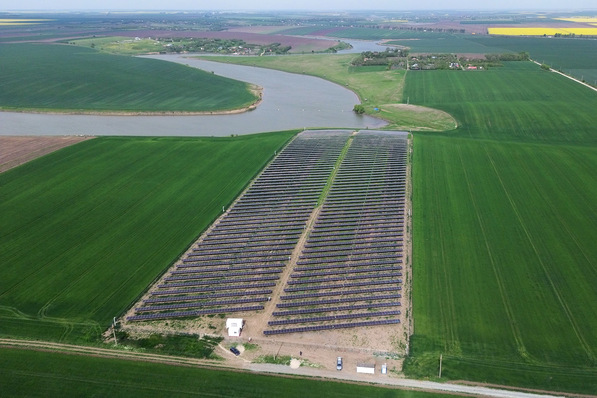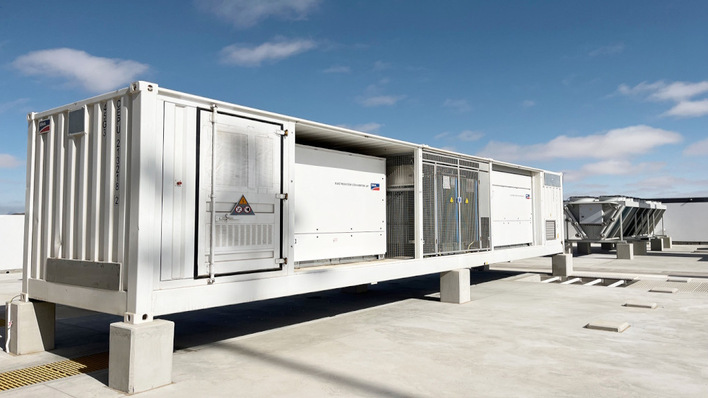Kropstädt is an inconspicuous town in Saxony-Anhalt, a stone’s throw from Wittenberg. Finding Kropstädt on a map is difficult – Wittenberg not at all. It is well known where Martin Luther nailed his theses to the church door. But industry insiders should now also keep the name Kropstädt in mind. Since early August of last year, Tesvolt are building their new commercial storage units there. A staff of ten are producing about 1.6 megawatt hours’ worth of capacity.
At the Intersolar, Tesvolt presented their new product range called Li, which have between ten and 120 kilowatt hours of storage capacity. “We have stopped building lead acid storage units altogether,” Daniel Hannemann, CEO of Tesvolt says, when we visited the production line.
Lead batteries are a thing of the past at Tesvolt
Initially, Tesvolt started out in lead acid technology and gathered extensive experience in large-scale storage systems. Nowadays, they exclusively use lithium iron phosphate batteries. “The price advantage of lead batteries is no longer significant in high-performance commercial applications. They are now only 15 to 20 percent cheaper than batteries made with lithium iron phosphate,” Simon Schandert says. He is head of engineering at Tesvolt. “You can only half discharge a lead acid cell, so in effect you need twice the gross capacity compared to lithium storage systems. If you factor in their considerably greater number of charging cycles, lithium iron phosphate batteries make much more sense, economically.”
Tesvolt buy in their high-performance cells from an Asian producer that also makes batteries for electric cars and busses as well as boats and telecoms back-up systems.
Lithium battery cells of 200 ampere hours
The Li-60 series with 60 kilowatt hours is particularly in demand. When assembling it, Tesvolt bracket together six cells into one block, with 96 cells in one Li-60 cabinet. Within each block, the cells are connected in parallel, while the blocks in the cabinets are in series. For that reason, all sizes of the Li series are structured the same way, what varies is just the number and combination of cells or battery blocks.
Every battery block has its own sensor that continuously measures voltage and the temperature at the terminals. “Those are the two critical parameters,” Simon Schandert says. “The cells’ temperature does not become a problem, if the pattern of charging and discharging is set up correctly. We adapt the charging specifications to the batteries, to ensure that they are charged or discharged at a rated current load of about 0.3 to 0.5 C. A temporary maximum load of 1 C in case of peak loads is not a problem.”
Measuring temperatures precisely for best performance
At temperatures below five or above 40 degrees Celsius, the load on the system is reduced. “A lithium iron phosphate battery performs best at 20 to 30 degrees, resulting in a long battery life,” Schandert explains. “That is why the current loads are reduced when temperatures go too high or too low, in order to ensure the longest battery life possible.”
At sub-zero temperatures, the storage unit switches itself off. The same is true for temperatures above 45 degrees. Recently, the first Li-60 was delivered to Siberia. Because in winter, temperatures can easily go below -40 degrees Celsius, the unit was set up inside the container which also is the service room for the engineer on duty. Generally, the Li storage units are designed for indoors use, without air conditioning. Four Li-60s have already been installed at London’s largest flower market (240 kilowatt hours at a charging capacity of 72 kilowatts).
If the ambient temperature at the site of the storage unit falls below zero degrees, to be safe, the battery management system disconnects it from the grid. This avoids charging and subsequently doing damage to the battery below freezing, because otherwise there is the danger of formation of dendrites, metallic needles that could penetrate the separators. The disconnecting happens through DC relays attached directly to the battery at either terminal. These work redundantly, and so the positive and negative terminals can be (dis)connected independently of each other.
A good match is the heart of the battery cabinet
The bi-directional battery management system is the heart of the storage unit. It is the area of expertise of Simon Schandert and the technicians and engineers working with him. When the sub-assembly that contains the control unit is wired together with the battery blocks, Schandert refers to them as being a ‘match’, just as when an engine is mounted on the chassis of a car.
An Li-60 can be assembled and be ready for shipment within a single day. Connection to the BatFuse, a fuse box for the battery, is achieved through two DC connection cables at the rear of the unit.
Tesvolt’s customers themselves, i.e. the local technicians, do the work of adapting the length of cables to the circumstances on site. The entire unit can be installed using only a screwdriver and a spanner. It can be moved using a pallet jack or a forklift, or in case of inaccessible places or basements, it can be completely disassembled and put together again on site. Disassembling a storage unit will take two technicians about half a day. The Li-60 weighs about a ton and the smaller Li-10 unit 150 kilograms. Because the steel frame of the battery cabinet is very sturdy, it is possible to stack a number of Li-10s on top of each other.
The modular system comes with SMA
The power electronics units are based on SMA’s (Sunny Island) charging controller. The battery is managed and controlled using an app on a tablet. It is connected through Bluetooth and constantly gets updated with operational data. If a cell weakens, the app will show that immediately. “We are also able to selectively move energy from one cell to another,” Simon Schandert sais. “This not only allows us to charge and discharge quickly and seamlessly, we also achieve an extremely high level of efficiency for the overall system.”
The storage system can be expanded to up to four battery cabinets with up to three Sunny Islands (for example, 240 kilowatt hours at 18 kilowatts of charging capacity from three Sunny Islands 8.0H units).
High level of efficiency for the overall system
The units started to be sold at the Intersolar in June of 2015, and demand has not slackened since. First enquiries are also coming in from Austria, Switzerland and Italy.
The battery blocks run on 48 volts. “The low voltage brings the advantage that the technician can also install the battery blocks himself,” Schandert sais. “He can start out with 30 kilowatts and later add another 30 kilowatts. At higher voltages, special training would be required to install and maintain the storage units. Many technicians like to wire the cabinets themselves in order to fit them exactly to their customers’ needs.”
Tesvolt’s storage unit makes use of 80 to 83 percent of the energy. So far, 70 to 76 percent has been the standard for lithium batteries. The reason why Tesvolt collaborates so closely with SMA is that the Sunny Island has an almost unbeatable advantage: The efficiency stays nearly constant at 92 percent from very low partial loads of 5 percent all the way to full load. Other inverters often show much higher losses, especially at partial load. That is why Tesvolt storage units can achieve 83 percent efficiency under real-life conditions.
Designed like an off-grid system
Furthermore, the Sunny Island has an emergency back-up function and off-grid capability. The UK and Russia have strict ordinances regulating that storage units must not feed electricity back into the grid, but have to run in zero-feed-in mode. “So you have to design this unit like an off-grid system,” Schandert explains. “In off-grid mode, the three inverters can produce up to 900 amperes of current. The battery has to be able to deal with that.”
The battery management system has been certified by the TÜV Rheinland. Until the end of the year, the unit should also have earned all other tests and certificates that the safety guidelines require.
In Germany, such storage unit are deployed in agriculture or in small enterprises. A dairy farmer in northern Germany uses batteries to run his milking parlour on solar energy. Cows are usually milked in the early morning between 5 and 6 o’clock and again in the late evening after 7.
While refrigeration and the feeding system are the base load, the mechanised milking system generates a significant load spike – just at times of day when PV not yet or no longer produces electricity. “In that case, the storage unit acts like a phase shifter,” Simon Schandert explains. In combination, PV and commercial storage are much more economic than a solar generator by itself.”
In Russia, for the first time storage units do not run in combination with PV systems, but in tandem with cogeneration plants. The Sunny Island can deal with any kind of generator. One of Tesvolt’s partners is a Russian builder of cogeneration plants whose power consumption sank due to the storage unit and using fuel more efficiently.
Tesvolt grants the usual product warranty of two years, a cell value replacement warranty lasting seven years and the performance warranty for ten years. Return and recycling is free, in accordance with the relevant regulations for batteries.
Once a month, Tesvolt trains 30 technicians in correctly setting up the Li storage units. “Commercial storage opens up a whole new market segment,” Daniel Hannemann is certain. “We see great opportunities in the area of petrol and service stations, in supermarkets, hotels, manufacturing companies and in agriculture.”
(HS/IR)
---
Did you enjoy reading "Tesvolt Storage Technology: A match made in Kropstädt"? You might be interested in the following article: "SMA and Tesvolt Cooperate in Commercial Storage System Development and Distribution".
Also, find out which opportunities Andreas Piepenbrink, the CEO at E3/DC sees for the energy storage market, or read the exclusive interview with Santiago Senn, director of LG Chem Europe on pv Europe in which he discussed innovation in storage systems, markets and distribution.







